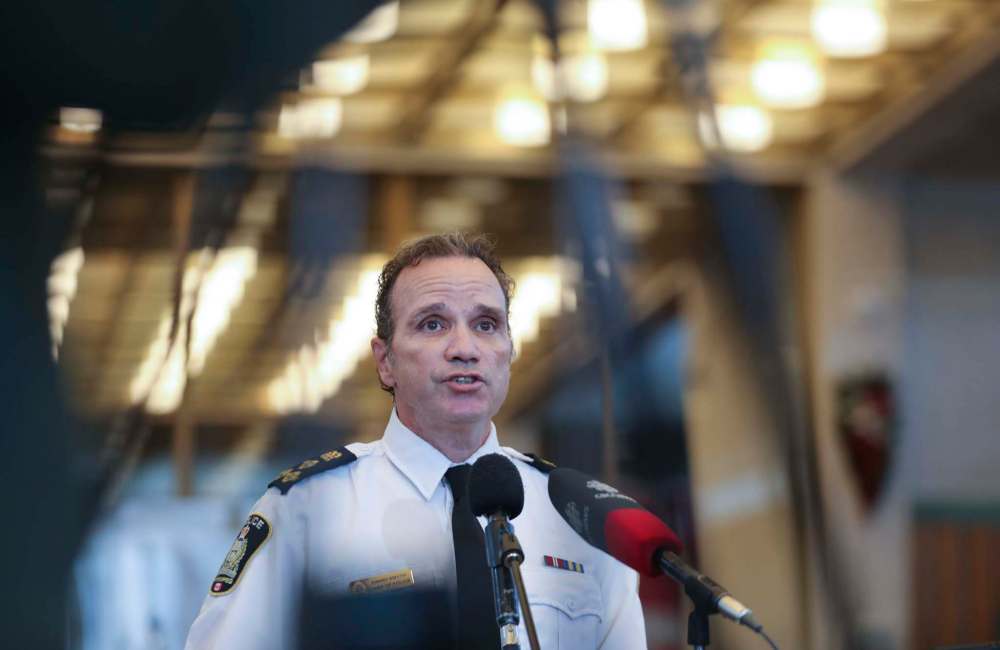City must scrutinize gap between police chief, officers
Read this article for free:
or
Already have an account? Log in here »
To continue reading, please subscribe:
Monthly Digital Subscription
$19 $0 for the first 4 weeks*
- Enjoy unlimited reading on winnipegfreepress.com
- Read the E-Edition, our digital replica newspaper
- Access News Break, our award-winning app
- Play interactive puzzles
*No charge for four weeks then billed as $19 plus GST every four weeks. Offer only available to new and qualified returning subscribers. Cancel any time.
Read unlimited articles for free today:
or
Already have an account? Log in here »
Hey there, time traveller!
This article was published 07/03/2021 (1397 days ago), so information in it may no longer be current.
Danny Smyth has been stuck between the proverbial rock and a hard place.
On the one side, the Winnipeg Police Service chief is facing mounting public pressure to reinvent policing in the city in the wake of a global reform campaign.
On the other, Smyth is struggling to placate increasingly frustrated and angry rank-and-file officers, who believe he has failed to protect them against a wave of anti-police sentiment.
Even though there has only ever been a sliver of breathing room between these two intractable constituencies, Smyth has somehow managed to avoid being crushed.
That was, until the events of last week.
In the course of 72 hours — March 3-5 — Smyth found himself confronted by an unprecedented campaign by the Winnipeg Police Association (the union that represents more than 1,800 officers and civilian support staff) to force him to step down.
The origins of the dispute had been percolating for months, if not years. However, a collision of somewhat disconnected events seems to have pushed things to the breaking point.
On Feb. 21, a 43-year-old constable died by suicide. The constable’s family published an obituary suggesting public criticism of policing, sparked by local and global protests against systemic racism in police culture, had pushed him to take his own life.
Smyth became the subject of criticism among many officers for not reaching out directly to the family. (Although he has not explained the delay, Smyth is renowned for being emotionally reserved to the point of appearing indifferent.)
WPA president Maurice Sabourin said Smyth did not meet with the constable’s family until March 3 — a period of 10 days — when the chief had a private meeting with them in his office at the downtown police headquarters.
Meanwhile, with resentment brewing on that front, Smyth issued a forceful internal memo March 1 — announcing an internal investigation to find the author of two false memos circulated to all rank-and-file officers.
The fakes were designed to look like the notices Smyth regularly sends out, but contained irreverent and sarcastic language about officers who had been accused of using excessive force. “This person (who authored the phony memos) has no place in our organization,” Smyth wrote.
It was too much for the WPA.
Sabourin penned his own memo, which claimed the service was suffering from a morale crisis “tied to growing concerns over the leadership of our current chief of police.”There is little doubt Smyth is losing his grip on the leadership of the WPS.
In media interviews, Sabourin went even further, suggesting the relationship between officers and the WPS chief was beyond salvage.
To no doubt ratchet up the pressure, the WPA is commissioning an updated health and wellness survey with its members. On Wednesday, Sabourin will meet with Curtis Griffiths, a criminologist at the University of British Columbia, who is being retained to conduct the survey.
Griffiths is well-versed in the culture of the WPS. In 2013, he did both an operational review and a health and wellness survey of its officers that revealed alarming levels of depression and substance abuse among Winnipeg police.
It’s unknown at this point whether the WPA on its own can exert enough pressure to get Smyth to step down, or to force city council into making the decision for him.
However, there is little doubt Smyth is losing his grip on the leadership of the WPS.
Smyth declined an interview request, but it should be noted he does occupy a precarious position in the ongoing public debate about police culture.

Smyth has, for example, publicly acknowledged systemic racism exists in the service. He has also been quick to own up to wrongdoing by officers accused of using excessive force.
While these are important things to say at a time of great social unrest, they have no doubt earned Smyth few friends in the ranks of the WPS.
Is there is a middle ground where Smyth could have acknowledged the problems with police culture without alienating a majority officers serving under him? This is where Smyth’s reserved leadership style, in general, and his failure to reach out to the family of the fallen police officer, in particular, comes into play.
Dishing out tough love is one of the tasks assigned to a police chief. But to do that effectively, the chief must have already earned the trust of the people they lead. Underlying this current dispute with the WPA is some pretty clear evidence Smyth is suffering from a trust deficit.
It may not be enough to get Smyth to step down.
However, it should be enough for city council to take a long look at the relationship between the police chief and WPS officers — and figure out whether there’s anything left to save.
dan.lett@freepress.mb.ca

Dan Lett
Columnist
Born and raised in and around Toronto, Dan Lett came to Winnipeg in 1986, less than a year out of journalism school with a lifelong dream to be a newspaper reporter.
Our newsroom depends on a growing audience of readers to power our journalism. If you are not a paid reader, please consider becoming a subscriber.
Our newsroom depends on its audience of readers to power our journalism. Thank you for your support.
















